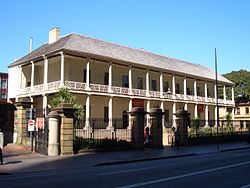 Museums of History NSW logo | |
 The Mint – Headquarters of MHNSW | |
| Agency overview | |
|---|---|
| Formed | 2022 |
| Preceding agency |
|
| Jurisdiction | New South Wales |
| Headquarters | The Mint, 10 Macquarie Street, Sydney, Australia |
| Employees | 354 (2024) [1] |
| Annual budget | A$73.6 million [2] |
| Minister responsible | |
| Agency executives |
|
| Parent department | Department of Enterprise, Investment and Trade |
| Parent agency | Create NSW |
| Child agencies |
|
| Key documents |
|
| Website | mhnsw |
Museums of History NSW is a statutory body of the government of New South Wales that is responsible for historic sites, state collections and archives in New South Wales, Australia. In 2023, the former State Archives and Records Authority was merged with Sydney Living Museums (formerly known as Historic Houses Trust of New South Wales) to form MHNSW. The sites include various houses, gardens, parklands and urban spaces. In 2011, its sites attracted over two million visitors each year. [4]









